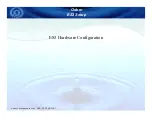
2. WIRING
2-14
Installing the Rectangular Waveguide (WRJ-9)
The RF interconnection between the antenna unit and the transceiver can be made with a
rectangular waveguide (WRJ-9) or flexible (FR-9). If the rectangular waveguide is used,
observe the following installation guidelines.
•
Correctly installed waveguide runs ensure the most efficient transmission of electrical
energy at high frequencies. Electrical losses, however, occur in the waveguide runs. To
minimize them the following factors are of great importance: minimum length, airtightness
and electrical continuity.
•
Another consideration required is that of frequency disturbance. The transmitting valve, a
magnetron, is the primary oscillator in the radar.
This is different from the oscillation system at lower frequencies in which conventional
radio valves are used. In the latter case, the primary oscillator is always protected from
the effects of load impedance by a buffer stage so that frequency and waveform are left
unobstructed. With a waveguide and magnetron, however, mismatch of impedance
causes “frequency pulling.” For this reason, the number of possible mismatches in a
waveguide run, i.e., joins and bends, must be kept minimum.
•
Each pair of flanges should be coupled with one O-ring, four bolts and spring washers
and the choke flange must be in the upper position. The bolts and O-ring must be
greased before insertion to facilitate removal if required at a later date.
•
The transceiver unit output flange is a plain type and the antenna unit output flange is a
choke type, and it is important to maintain this relationship throughout the waveguide run.
Thru-deck hole
TRANSCEIVER
UNIT
Watertight film
Drain waveguide
Weld here.
Deck
Flange connection
•
After installation of the waveguide is completed, the coupling portions must be sealed by
using the adhesive supplied.
•
In a very short time the surface of the waveguide becomes green with verdigris.
Therefore, paint both the surface of the waveguide and flanges to avoid corrosion and
water penetration. Paint must not be allowed to reach the inner surface of the waveguide
or the mating surface of any flange.
Summary of Contents for FAR-2827W
Page 21: ...1 MOUNTING 1 11 Mounting of antenna unit ...
Page 34: ...1 MOUNTING 1 24 This page is intentionally left blank ...
Page 86: ...3 SETTING AND ADJUSTMENT 3 22 This page is intentionally left blank ...
Page 106: ...4 INSTALLING OPTIONAL EQUIPMENT 4 20 This page is intentionally left blank ...
Page 132: ......
Page 133: ......
Page 134: ...Jan 24 07 R Esumi ...
Page 135: ......
Page 136: ...May17 07 R Esumi ...
Page 137: ......
Page 138: ......
Page 139: ...Jan 18 08 R Esumi ...
Page 140: ...Apr 23 07 R Esumi ...
Page 141: ...Apr 23 07 R Esumi ...
Page 142: ...Apr 23 07 R Esumi ...
Page 143: ...Apr 23 07 R Esumi ...
Page 144: ...Apr 23 07 R Esumi ...
Page 145: ......
Page 146: ......
Page 147: ......
Page 148: ......
Page 149: ......
Page 150: ......
Page 151: ......
Page 152: ......
Page 153: ......
Page 154: ......
















































